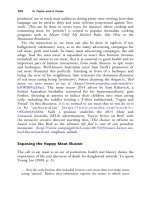The palgrave international handbook of a 505
Bạn đang xem bản rút gọn của tài liệu. Xem và tải ngay bản đầy đủ của tài liệu tại đây (36.36 KB, 1 trang )
508
M. Gupta et al.
to animals receives only brief treatment in the current edition of the
Diagnostic and Statistical Manual of Mental Disorders (DSM-V; American
Psychiatric Association 2013). The only DSM disorder for which cruelty to
animals is a diagnostic criterion is Conduct Disorder, and then only since the
1987 revision (DSM III-R). Zoophilia (sexual arousal involving animals) that
causes clinically significant distress or impairment in functioning is contained
in the category Other Specified Paraphilic Disorder (see also chapter herein
on Animal Sexual Abuse). However, if zoophilia does not cause distress or
functional impairment, it is not treated as a disorder according to DSM-V
criteria. There is no DSM-V distinction between individuals who act on the
arousal by committing animal sexual assault (bestiality) and those who do
not. The new diagnosis of Hoarding Disorder in DSM-V mentions animal
hoarding as a potential special manifestation of hoarding, which may spur
greater awareness on the topic in coming years. Although animal abuse has
been observed in clinical practice in association with numerous other mental
disorders, with initial research suggesting particular connections to personality disorders and substance use disorders (Gleyzer et al. 2002; Vaughn et al.
2009), it has not yet been established as a diagnostic feature of other
disorders such as would merit inclusion in their DSM criteria sets. Further
research examining potential patterns of association between animal abuse
and mental disorders is greatly needed.
For now, the upshot of this lack of awareness is that many practitioners do
not understand animal abuse and do not consider themselves competent to
work with individuals who have abused animals. From the current authors’
experiences leading trainings, it is clear that an additional subset of practitioners is unwilling to work with these individuals because of their own
discomfort in hearing about animal abuse and/or distaste for working with
individuals who have harmed animals. If an offender is referred (by a court,
guardian, etc.) for evaluation or intervention and no one will take the case,
this may serve to delegitimize animal abuse as a concern within the system
and discourage future referrals. At the same time, if referrals for animal abuse
evaluation/intervention are infrequent, there is little incentive for practitioners to become competent in handling these cases.
Perhaps the single most powerful change that could be made systematically is to integrate material on animal abuse and human-animal relationships into the standard training of human service professionals. While
specialized courses on the human-animal violence connection and the
human-animal bond are growing in popularity (Animals & Society
Institute 2016), it seems equally if not more important to reach those
practitioners and practitioners-in-training who do not already have a special









